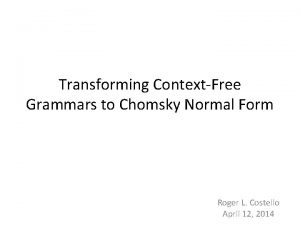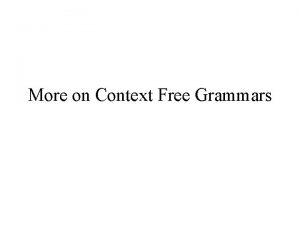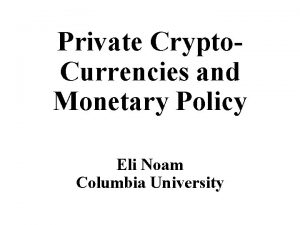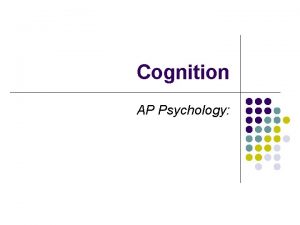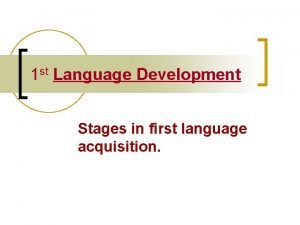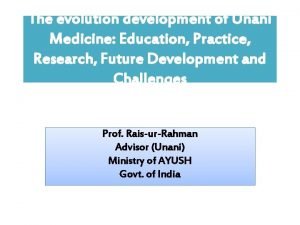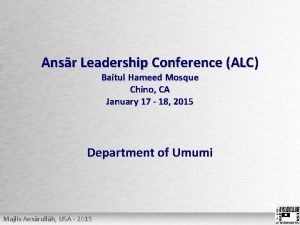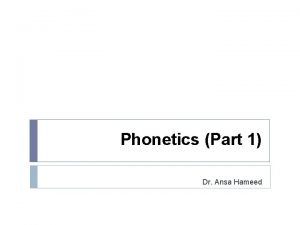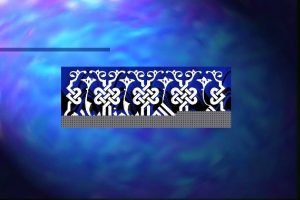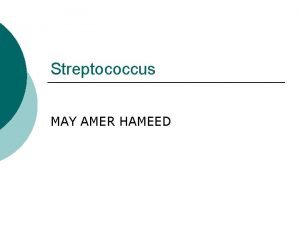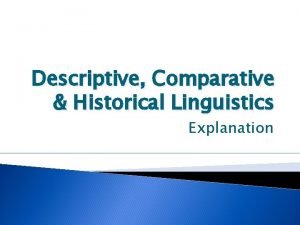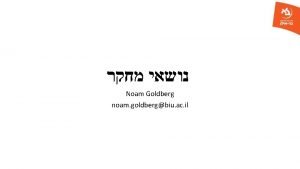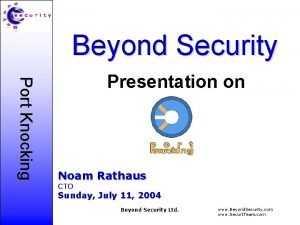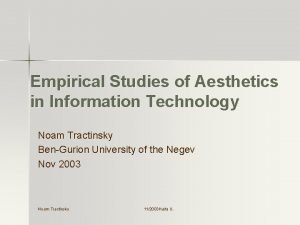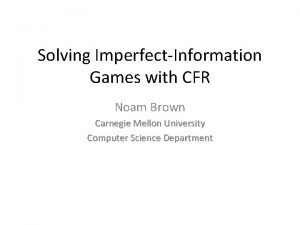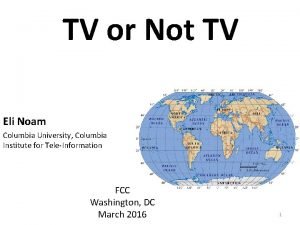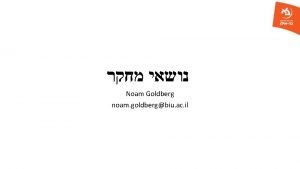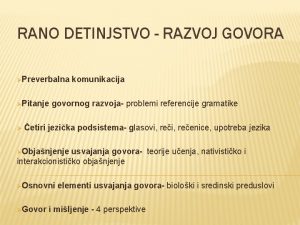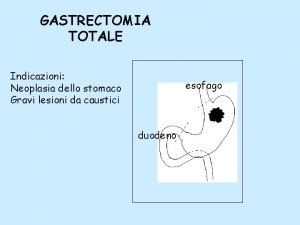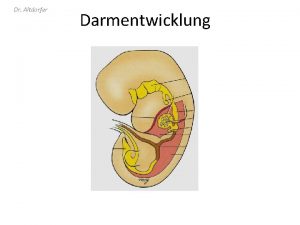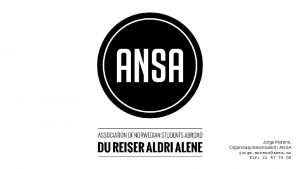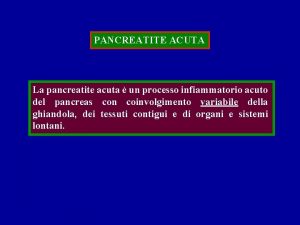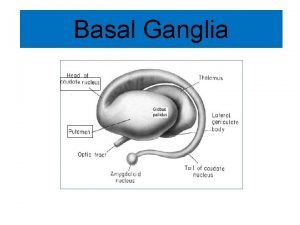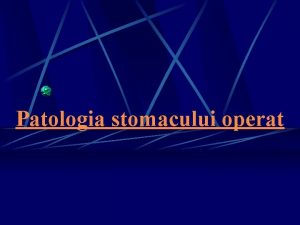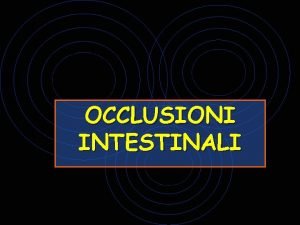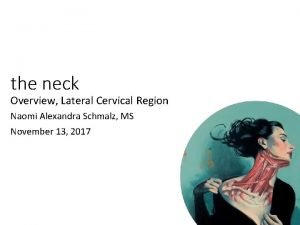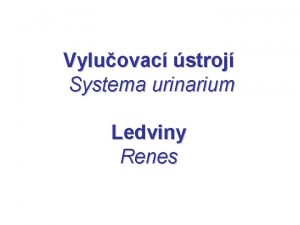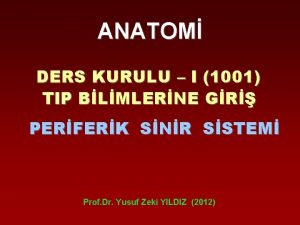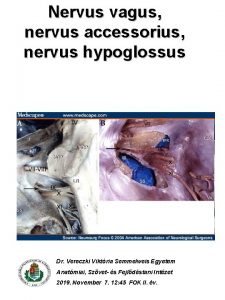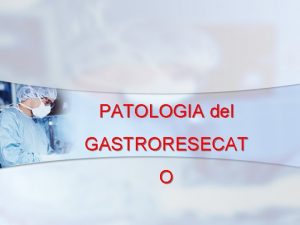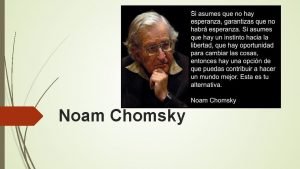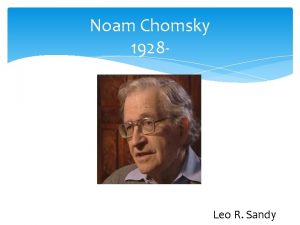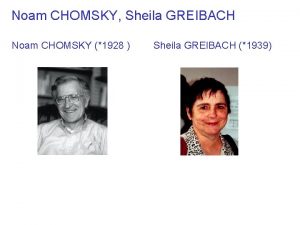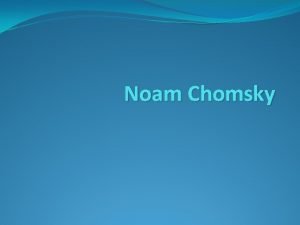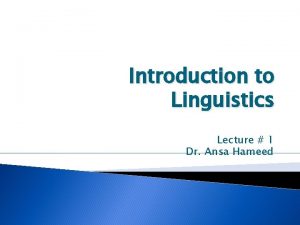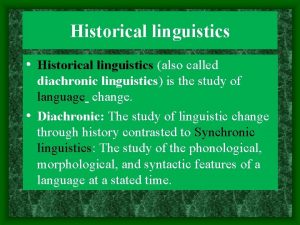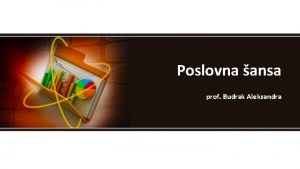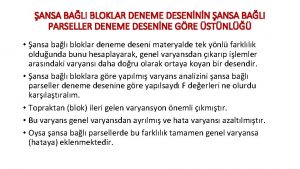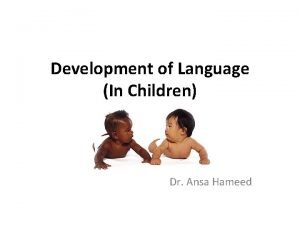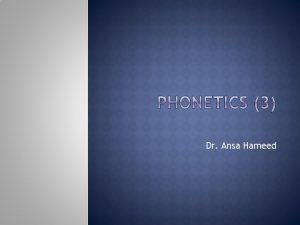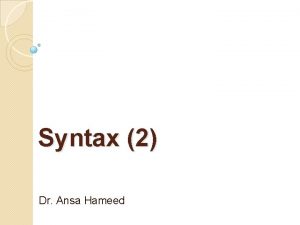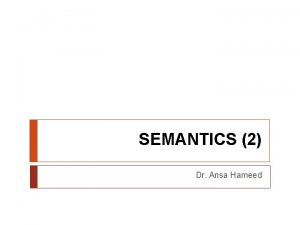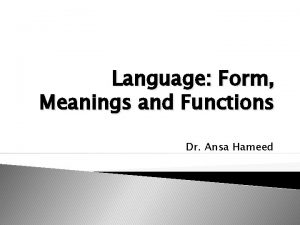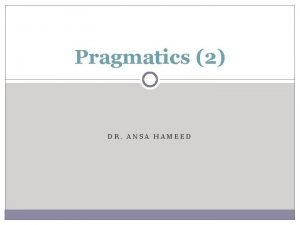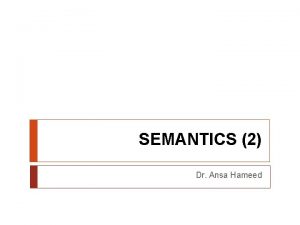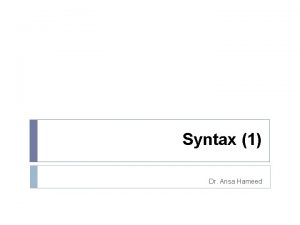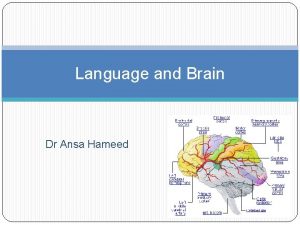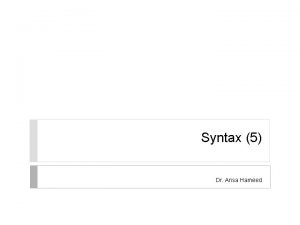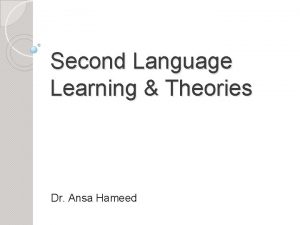HISTORICAL LINGUISTICS 2 NOAM CHOMSKY Dr Ansa Hameed


































- Slides: 34

HISTORICAL LINGUISTICS (2) NOAM CHOMSKY Dr. Ansa Hameed

Previously…. History of Linguistics Structuralism: Ferdinand de Saussure

Today’s Lecture Generative Linguistics Noam Chomsky Ideas About Language Phrase Structure Grammar Transformational Generative Grammar Chomsky theory of First Language Acquistion

Noam Chomsky: A New Paradigm in Modern Linguistics

GENERATIVE LINGUISTICS A school of thought within Linguistics. Makes use of the ´Concept of Generative Grammar` One great proponent of this concept is Avram Noam Chomsky Book: “Syntactic Structures” (1957) Famous for Transformational Generative Grammar.

Chomsky’s Brief Life History December 7, 1928: Chomsky was born. He attended the University of Pennsylvania where he met Zellig Harris 1949: He graduated with a BA. His thesis was about Modern Hebrew. He entered graduate school. 1951: He became one of the Society of Fellows at Harvard, from where he moved to the Massachusetts Institute of Technology (MIT) in 1955. He has been repeatedly jailed for political activism. (Smith, 2004). He has been influenced by a large variety of thinkers, philosophers, politicians and linguists. Many compare him to Bertrand Russel.

About Chomsky ‘‘He has shown that there is really one human language: that the immense complexity of the innumerable languages we hear around us must be variations on a single theme. He has revolutionized linguistics, and in so doing has set a cat among the philosophical pigeons. ” (Smith, 2004: 16).

Chomsky’s Ideas about Language Definition A language is a set (finite/infinite) of sentences, each finite in length and constructed out of a finite set of elements Language is a system represented in the mind/brain of a particular individual

Chomsky’s Idea of Competence & Performance Language Competence vs Performance Chomsky distinguishes between: � Competence: speaker‘s/ hearer‘s unconscious knowledge of language (about sounds, meanings, syntax) � Performance: actual use of language in concrete situations � Competence is mental reality and not directly observable whereas performance is observable

Chomsky’s Ideas about Aims of Linguistics Chomsky summarized the major aims of linguistics as to know: 1. 2. 3. 4. What constitutes language? How is such knowledge acquired? How is such knowledge put to use? What are the physical mechanisms that serve as the material basis for this system of knowledge and for its use?

Chomsky’s Ideas about Syntax Language is Structure- Dependent A principle common to all languages: Syntax is more than meaning Chomsky asserts that knowledge of language relies on the structural relationships in the sentence rather than on the sequence of words Example: The man who is tall is John. Is the man who is tall John? *Is the man who tall is John?

Syntax is more than meaning Well-formed sentence without meaning: Colorless green ideas sleep furiously. Syntax as well as meaning deprived of inner logic: Ideas furiously green colorless sleep.

Chomsky’s Models of Grammar Chomsky introduced three models of grammar: Finite state Grammar (most basic and inadequate) Phrase Structure Grammar Transformational Generative Grammar (Extension of Phrase Structure Grammar)

Phrase Structure Grammar Rules for determining the structure of phrases Generate a lot of sentences from a small number of rules. The structure of a phrase will consist of one or more constituents in a certain order. Constituent: Ø Ø Some words seem to belong together: {The crazy man} {is jumping off the bridge} Groups of words that belong together are called constituents The component that determines the properties of the constituent is the head, and the constituent can be referred to as a phrase: e. g. noun phrase

Phrase Structure Grammar Explanation: V Det N V Det N run a marathon eat the food read the book V Prep Det N go to the store talk with a teacher V Det N Prep Det N take your sister to the library “Verb phrases have a V, (sometimes) an NP, and (sometimes) a PP” VP -> V (NP) (PP)

Phrase Structure Grammar The main phrase structure rules: 1. S NP VP 2. NP {Det N, Pro} 3. VP V (NP) (PP) (Adv) 4. PP P NP 5. AP A (PP)

Phrase Structure Grammar Phrase Structure Rules & tree diagrams NP (Det) N PP P NP The boy (NP) Det N The boy in the yard Det N PP P The boy in NP Det N the yard

Phrase Structure Grammar Ø Some Limitations with Phrase Structure Grammar The rules are mostly context free. The rules explain intra-sentence constituent elements (syntax) but not inter-sentence relations (Syntactic) Ambiguous sentences cannot be explained These problems were solved with transformational generative grammar

Deep & Surface Structures (Before moving further)* q Ø q Syntactic Relationships have two levels of representation: Surface Structure (SS): derived (surface) representation of a Deep Structure how the sentence is actually represented Deep Structure (DS): represents syntactic relations (underlying representation)

Deep & Surface Structures Ø The deep structure is an abstract level of structural organization in which all the elements determining structural interpretation are represented. � Sentences that have alternative interpretations � Sentences that have different surface forms but have the same underlying meaning. SS can be derived from DS by transformations like passivization, forming of questions etc.

Deep & Surface Structures How superficially different sentences are closely related? � Charlie broke the window. � The window was broken by Charlie � Charlie who broke the window. � Was the window broken by Charlie? Difference in their surface structure = difference in syntactic forms Ø BUT they have the same ‘deep’ or underlying structure Ø

Deep & Surface Structures How superficially similar sentences are different? (multiple meanings) Annie whacked the man with an umbrella. Same surface structure but different deep structure The boy saw the man with a telescope.

Transformational Generative Grammar has two aspects: Transformational Generative

Transformational Grammar § § Transformational is a method of stating how the structures of many languages can be generated or explained as the result of specific transformations applied to certain basic* structure. Transformations I helped John. (Active) John was helped by me. (Passive) He will come. (affirmative) Will he come? (Interrogative)

Transformational Grammar § Ø Ø § Ø Transformational Rules* Prescriptive/ Normative Rules: Avoid ending sentences with prepositions The difference between ‘owing’ and ‘due to’ Where to use ‘I’ or ‘me’ Other traditional rules derived from other classical languages Descriptive Rules: Based on observations and inductive rules what happens in language (e. g. He makes. . . I make…. ) Rewrite Rules: This system deals with symbols. (use of symbols to representence: Example, S NP+VP)

Transformational Grammar § Ø Ø § Ø Ø Interrogative Rules: Rules to make question statements (Example: I can read. (DS) / Can I read? (SS)) Affix Switch Rules: Changing form by moving affix (Example: He is going. (DS) / Is he going? (SS)) Do-Support Rules: Use of Do, Does (Example: He watches T. V. (DS) / Does he watch T. V? (SS)) Negation Rules: Making negative sentences (Example: She likes movies. (DS) / She does not like movies. (SS)) Passivation Rules: Changing voice (active…passive) (Example: I play Hockey. (DS) / Hockey is played by me. (SS))

Generative Grammar Ø Ø Formally, a generative grammar is defined as one that is fully explicit. It is a finite set of rules that can be applied to generate all those and only those sentences (often but not necessarily, infinite in number) that are grammatical in a given language (Chomsky) Explicit means what are possible sentences of language To say a grammar generates a sentence is technical which means grammar assigns a structural description to sentences* Ø “all and only”= all grammatical sentences and only grammatical sentences Ø Finite rules infinite number of well-formed sentences

Generative Grammar Properties of Generative Grammar It includes whatever is in phrase structure grammar and transformational grammar and further takes into account all possible syntactic structures The grammar has finite number of rules but capable to produce infinite number of structures. In this way, productivity in language is covered.

Chomsky against Behaviourism In the late 1950 s, Skinner constructed his cognitive learning model: behaviorism which correlates with the notion. Stimulus → response→ reinforcement and habit formation • According to Skinner, children learn the language by imitating and repeating and the mind is a blank slate at birth. According to Chomsky, Children are biologically programmed for language and language develops in the child in just the same way that other biological functions develop. •

Chomsky theory of First Language Acquistion “ We are designed to walk. . That we are taught to walk is impossible. And pretty much the same is true of language. Nobody is taught language. In fact you can’t prevent a child from learning it” Chomsky 1994 “We are born with a Language Acquisition Device (LAD) and access to Universal Grammar (UG)”

Chomsky’s Idea of Universal Grammar Concept of Universal Grammar the system of principles, conditions, and rules that are elements or properties of all human languages, … the essence of human language. (Chomsky, 1976) All human beings share part of their knowledge of language that is universal grammar (existing as part of language Competence) Speaker knows a set of � � principles that apply to all languages, parameters that vary within clearly defined limits from one language to another UG is an attempt to integrate grammar, mind and language

L. A. D • • • L. A. D is a function of the brain that is specifically for learning language. It is an innate biological function of human beings just like learning to walk. L. A. D plays two roles in Chomskyan theory: 1. It accounts for the striking similarities among human languages. 2. It accounts for the speed, ease and regularity with which children learn their first language. If the sequence order is the same in all children, it is then quite normal to speak about language universals.

Recap Generative Linguistics Noam Chomsky Ideas About Language Phrase Structure Grammar Transformational Generative Grammar Chomsky theory of First Language Acquistion

References Carnie, Andrew. Syntax- A Generative Introduction. 2002. Falk, Julia. Linguistics and Language. 1978. Ouhalla, Jamal. Introducing Transformational Grammar. 1999. Parsad, Tarni. A Course in Linguistics. 2012. Neil, S. (2004). Chomsky: Ideas and Ideals. New York: CUP. Yule, George. The Study of Language. 1996.
 Noam chomsky normal form
Noam chomsky normal form Chomsky normal form 설명
Chomsky normal form 설명 Tzarget
Tzarget Embodied cognition ap psychology definition
Embodied cognition ap psychology definition Noam chomsky child development
Noam chomsky child development Chomsky computational linguistics
Chomsky computational linguistics Hakim abdul hameed
Hakim abdul hameed Chino masjid
Chino masjid Part 1 phonetics
Part 1 phonetics Hameed urban dictionary
Hameed urban dictionary Bacterial capsul
Bacterial capsul Applied linguistics
Applied linguistics Language
Language Scope of historical linguistics
Scope of historical linguistics Historical linguistics
Historical linguistics Noam goldberg
Noam goldberg Noam rathaus
Noam rathaus Noam tractinsky
Noam tractinsky Noam brown
Noam brown Columbia
Columbia Noam goldberg
Noam goldberg Noam čomski
Noam čomski Ansa alla roux
Ansa alla roux Arcus riolani minor
Arcus riolani minor Ansa forsikring
Ansa forsikring Mutazioni genetiche
Mutazioni genetiche Fiziologia rinichiului
Fiziologia rinichiului Lentiform nucleus
Lentiform nucleus Ansa aferenta
Ansa aferenta Ansa intestinale
Ansa intestinale Cervical lymph nodes
Cervical lymph nodes Margo plicatus
Margo plicatus Nervus maxillaris dalları
Nervus maxillaris dalları Nervus accessorius
Nervus accessorius Gastrodigiunostomia
Gastrodigiunostomia
